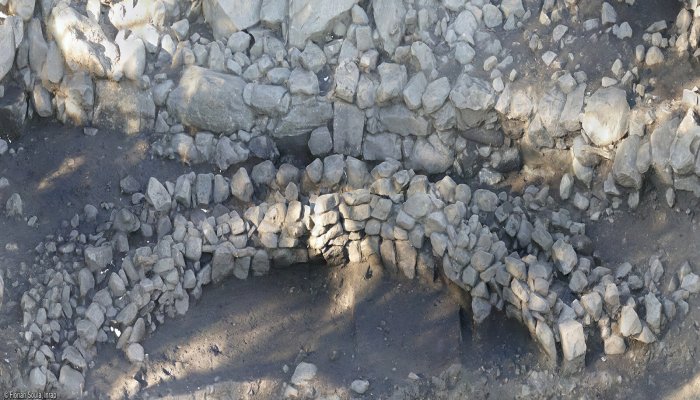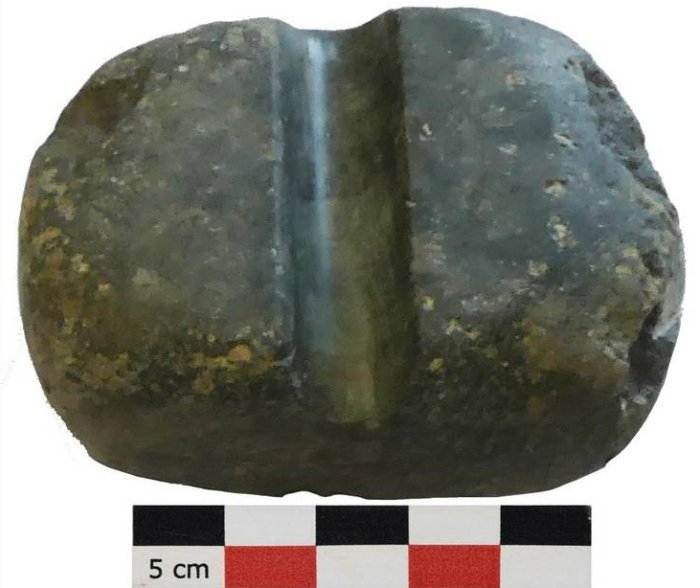6,000-Year-Old Vast Settlement With Tools And Granite Structures Unearthed In Sotta, Corsica In France
Conny Waters - AncientPages.com - A team of archaeologists from INRAP (French National Institute for Preventive Archaeological Research) recently unearthed two Neolithic settlements of which one has well-preserved structures.
The excavataed arc was the best preserved of its kind at the site, experts said. Image credit: Florian Soula INRAP
INRAP researchers inform that the remains of this vast settlement are located on the slopes of the southern flank of Punta Campana, in Sotta, and include a large number of ancient artifacts.
In the first settlement that dates to the beginning of the fourth millennium B.C to about 6,000 years ago, researchers found a stone structure filled with remains of an obsidian cutting workshop. This part of the excavated place was found to be partially eroded.
The second settlement dates to the third millennium BC., about 4,000-5,000 years ago, it was better preserved, and there, the team uncovered a system of terraces, topped with an approximately 3-foot tall or fortified wall made of granite blocks, according to researchers. The structures were excavated between November 2022 and March 2023,.
General view of a bastion being excavated in Sotta (Southern Corsica) in 2023. © Florian Soula, Inrap
“The top of the excavation right-of-way presents a more complex organization, with a "bastion" supported by an imposing terrace wall, fully preserved and measuring about 0.9 to 1.2 m in height compared to the level of circulation preserved. This wall is built of large granite blocks with an upper base of blocks laid flat,” according to INRAP press release.
On the first terrace below it was a stone arc also made from granite blocks. The building techniques used in the arc indicate it was used as some kind of roof, but experts are investigating its exact purpose, they said. The excavataed arc was the best preserved of its kind at the site.
Within the terraced structure, researchers discovered a corridor and staircase that probably functioned as a passageway to the upper level of the system. .
Among the smaller remains were artifacts indicating artisan practices in daily life, researchers said. Florian Soula INRAP
Within the corridor, several vases were unearthed. A pear-shaped vase was among several vases discovered on the paving inside the wall of the terraced structure
Also, two other similar terraced systems were found at the site; but for now, their purpose is unclear. Possibly they were used for food storage, metallurgy, or other artisans' activities.
The excavating team discovered many unusual artefacts at the Neolithic site and particularly, in the terraced section. These include thousands of unusual copper and other metal artifacts, obsidian, quartz, pieces of flint, wheels, arrowheads; axes, and other metal objects.
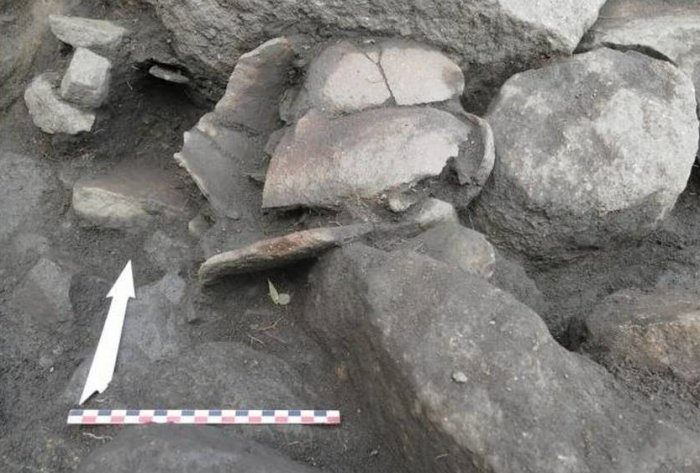 A storage vase was also found among the artifacts, experts said. Florian Soula INRAP
A storage vase was also found among the artifacts, experts said. Florian Soula INRAP
Some remains show traces of melting that took place at the site. There were also cattle teeth and rare cranial skeletal remains that seemed to have been burned, INRAP informed.
Other artifacts gave experts greater insight into life during the Neolithic era and at the settlement in particular. Among the smaller remains were artifacts indicating artisan practices in daily life, researchers said.
The artifacts indicate the presence of intense and/or long-term activities concerning all aspects of daily life and economy of Neolithic societies.
Further studies will no doubt will help to obtain give a greater view into ancient life of the ancient societies in Sotta on the island of Corsica.
Written by Conny Waters - AncientPages.com Staff Writer
More From Ancient Pages
-
 10 Mysterious Ancient Manuscripts With Hidden Secrets
Featured Stories | May 27, 2016
10 Mysterious Ancient Manuscripts With Hidden Secrets
Featured Stories | May 27, 2016 -
 Why Napoleon’s Invasion Of Russia Was A Fiasco
Ancient History Facts | Mar 31, 2017
Why Napoleon’s Invasion Of Russia Was A Fiasco
Ancient History Facts | Mar 31, 2017 -
 History Of The Saltire – Scotland’s National Flag And World’s Oldest Sovereign Flag
Featured Stories | Apr 3, 2016
History Of The Saltire – Scotland’s National Flag And World’s Oldest Sovereign Flag
Featured Stories | Apr 3, 2016 -
 Oldest Known Evidence Of Artificial Cranial Deformation Revealed In Croatia
Archaeology | Aug 26, 2019
Oldest Known Evidence Of Artificial Cranial Deformation Revealed In Croatia
Archaeology | Aug 26, 2019 -
 Teaching Is Not Essential For People To Learn How To Make Tools, Study Says
Archaeology | Dec 6, 2015
Teaching Is Not Essential For People To Learn How To Make Tools, Study Says
Archaeology | Dec 6, 2015 -
 Huldra: Seductive Female Creature Living In Forest Or Mountains In Norse Beliefs
Featured Stories | Feb 8, 2018
Huldra: Seductive Female Creature Living In Forest Or Mountains In Norse Beliefs
Featured Stories | Feb 8, 2018 -
 The Oseberg Tapestry And Other Artifacts Show Intense Colors Were A Viking Symbol Of Status And Wealth
Featured Stories | Sep 27, 2021
The Oseberg Tapestry And Other Artifacts Show Intense Colors Were A Viking Symbol Of Status And Wealth
Featured Stories | Sep 27, 2021 -
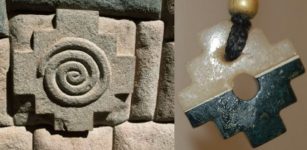 Mysterious Chakana – Sacred Inca Cross And Its Connection To The Southern Cross Constellation
Ancient Symbols | Sep 15, 2018
Mysterious Chakana – Sacred Inca Cross And Its Connection To The Southern Cross Constellation
Ancient Symbols | Sep 15, 2018 -
 Cuauhtémoc: Brave And Determined Ruler Of Tenochtitlan And The Last Aztec Emperor
Featured Stories | Feb 28, 2018
Cuauhtémoc: Brave And Determined Ruler Of Tenochtitlan And The Last Aztec Emperor
Featured Stories | Feb 28, 2018 -
 1,750-Year-Old Fresco Travertines Buried Underground – Recovered In Ancient Laodicea
Archaeology | Mar 19, 2020
1,750-Year-Old Fresco Travertines Buried Underground – Recovered In Ancient Laodicea
Archaeology | Mar 19, 2020 -
 Alux: Little Mythical Troublemaker And Guardian Of Corn Fields In Mayan Folklore
Featured Stories | Jun 11, 2019
Alux: Little Mythical Troublemaker And Guardian Of Corn Fields In Mayan Folklore
Featured Stories | Jun 11, 2019 -
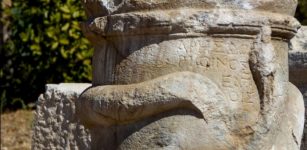 2,000-Year-Old Altar Depicting Snake Figure Unearthed In Lycian City Of Patara
Archaeology | Oct 20, 2020
2,000-Year-Old Altar Depicting Snake Figure Unearthed In Lycian City Of Patara
Archaeology | Oct 20, 2020 -
 Mary Boleyn – King Henry VIII’s Other Woman And Sister Of Anne Boleyn
Featured Stories | Jul 24, 2018
Mary Boleyn – King Henry VIII’s Other Woman And Sister Of Anne Boleyn
Featured Stories | Jul 24, 2018 -
 Ankhesenamun – Mysterious Death Of Tutankhamun’s Wife Ended The True Amarna Bloodline
Featured Stories | Mar 23, 2018
Ankhesenamun – Mysterious Death Of Tutankhamun’s Wife Ended The True Amarna Bloodline
Featured Stories | Mar 23, 2018 -
 Rosicrucians: Facts And History About The Mysterious Secret Society
Featured Stories | Oct 20, 2016
Rosicrucians: Facts And History About The Mysterious Secret Society
Featured Stories | Oct 20, 2016 -
 Mystery Of The Patagonian Giants: Europe’s Lost Race From The ‘Land Of The Bigfeet’
Featured Stories | Jun 20, 2020
Mystery Of The Patagonian Giants: Europe’s Lost Race From The ‘Land Of The Bigfeet’
Featured Stories | Jun 20, 2020 -
 On This Day In History: 150 Highly-Trained Swiss Guards Entered Vatican For The First Time – On Jan 22, 1506
News | Jan 22, 2017
On This Day In History: 150 Highly-Trained Swiss Guards Entered Vatican For The First Time – On Jan 22, 1506
News | Jan 22, 2017 -
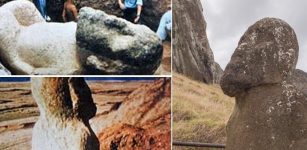 Unusual Tukuturi Statue On Easter Island Remains An Unexplained Mystery
Civilizations | Jan 16, 2019
Unusual Tukuturi Statue On Easter Island Remains An Unexplained Mystery
Civilizations | Jan 16, 2019 -
 Incredible Find – 3,000-Year-Old Canoe Found In Wisconsin’s Lake Mendota
Archaeology | Sep 25, 2022
Incredible Find – 3,000-Year-Old Canoe Found In Wisconsin’s Lake Mendota
Archaeology | Sep 25, 2022 -
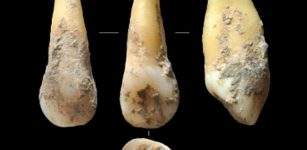 Common genetic origin for farmers from Central Europe and the Mediterranean area
Human Beginnings | Sep 5, 2015
Common genetic origin for farmers from Central Europe and the Mediterranean area
Human Beginnings | Sep 5, 2015

